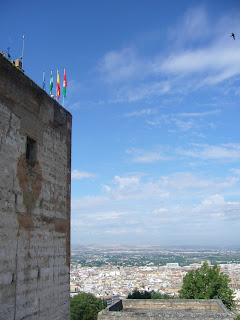Granada is the capital of the southern-most province Spain known as
Andalucia. It has been an important city in Spanish history since the middle ages. First ruled by Muslim caliphs, then conquered by the great Isabelle and Ferdinand, the Holy Roman Emperor, and taken by Napoleon, Granada is a sophisticated city that resembles Paris and Madrid mixed together. The greatest monument though is the Alhambra. The great fortress-turned-palace nestled in the hills above the now modern city.
Getting into the site is a bit of an ordeal for tourists. You have to book in advance unless you want to wait in line for tickets without promise that you will actually get in. The complex is high above the city and is a steep climb uphill for at least 40 minutes walking or a scary, twisty-turny bus or taxi ride for ten minutes. Tickets are about $20 a piece and you have get there at least 1 hour before your scheduled time (booked in advance).
All of this is well worth it. You cannot imagine the beauty, the power, and the importance of this site. It is a UNESCO World Heritage site and it is certainly the building that lays the foundation of Spanish architecture. Not to mention, it is a place where history can literally be felt, hanging in the air.
In the 19th century American writer Washington Irving spent a summer writing in the Alhambra. I will use his very-romantic-a-bit-too-dreamy-19th-century (which I love) words to accompany my pictures since I think he can evoke a bit more from the pictures than my own dry words.
View of the Alhambra on a rainy and cold day in June from the adjacent medieval village.
View up at the Alhambra from the valley below it (where the medieval gates begin)
Irving: For my part, I gave myself up, during my sojourn in the Alhambra, to all the romantic and fabulous traditions connected with the pile.
I lived in the midst of an Arabian tale, and shut my eyes, as much as possible, to every thing that called me back to every-day life. . .
Irving: In the silent and deserted halls of the Alhambra; surrounded with the insignia of regal sway, and the still vivid, though dilapidated traces of oriental voluptuousness, I was in the strong-hold of Moorish story, and every thing spoke and breathed of the glorious days of Granada, when under the dominion of the crescent.
The surfaces are covered in stucco and sculpted with words from the Koran.
Detail of stucco carving details (Allah)
 |
| Flowers and geometric patterns symbolize heaven (the perfection of Allah, who cannot be depicted in human form) |
 |
| The most famous part of the Alhambra, The Courtyard of Lions (now under restoration) |
 |
| The fortress (Napoleon destroyed a lot of it when he invaded Spain) |
 |
| View of the medieval city of Granada from the fortress (you can spy on every movement of your people) |
|
|
|
|
|
 |
| View of modern Granada |
Irving: Lovely Granada! City of delights! . . . .who ever made thy moon-lit balconies, thy gardens of myrtles and roses, of oranges, citrons, and pomegranates, respond to more tender serenades?
 |
| You can see into the hills for miles, perfect defense |
 |
| One of only two medieval entrance/exits into the complex |
|
 |
| The "modern" Renaissance palace of Charles V (the Holy Roman Emperor) doesn't fit into the Islamic style seen throughout the rest of the site, but it was built by a student of Michelangelo's to mimic the interior of St. Peter's Cathedral in Rome (which Michelangelo built). |
 |
| Gardens serve the purpose of relief from the Andalucian sun, but also symbolize paradise/heaven |
Irving: One of the greatest pleasures of the Spaniards is, to sit in the beautiful summer evenings, and listen to traditional ballads, and tales about the wars of the Moors and Christians, and the "buenas andanzas" and "grandes hechos," the "good fortunes" and "great exploits" of the hardy warriors of yore.
 |
| The summer home, located higher up on the site, it provides more shade and cooler breezes than the other palace |
 |
| Ferdinand and Isabelle's lions (added when they conquered the caliphate) |
 |
| View of the Alhambra from the summer home |
 |
| Exiting the Alhambra (away from tourists) the medieval road that leads to the fortress -- it is so steep! |
 |
| A short phrase, by an anonymous poet, on the wall of the Alhambra perfectly summarizes the beauty of this place: Dale limosna, mujer que no hay en la vida nada como la pena de ser ciego en Granada. -- Give him alms, woman, for there is no worse penalty in life than to be blind in Granada. |
























No comments:
Post a Comment
Note: Only a member of this blog may post a comment.